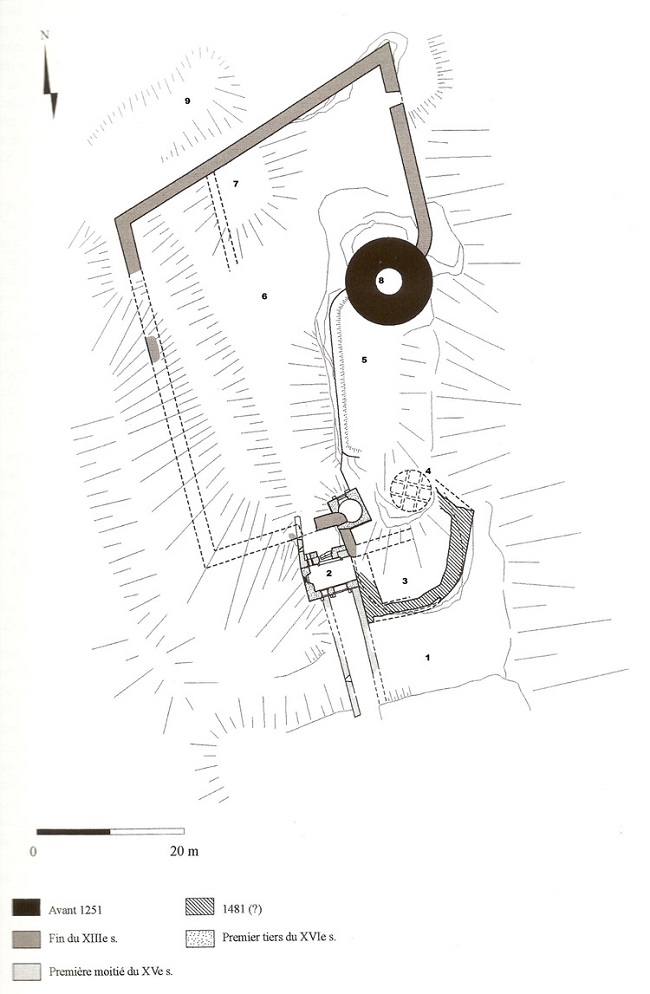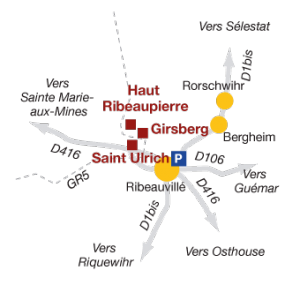Château du Haut-Ribeaupierre (Ribeauvillé)
Château du Haut-Ribeaupierre is one of the famous 3 castles of Ribeauvillé.
- Chateau du Haut-Ribeaupierre
- Chateau du Girsberg
- Chateau de Saint-Ulrich
- Château du Ribeauvillé or château Bas des Ribeaupierre
3 castles of Ribeauvillé
The three famous castles that overlook the medieval city of Ribeauvillé — Saint-Ulrich, Girsberg-Stein, and Haut-Ribeaupierre — are mentioned in a saying that dates back over three centuries:
“Three castles on a mountain (Ribeauvillé)
Three churches in an enclosure (Riquewihr)
Three towns in a valley (Ammerschwihr, Kaysersberg, Kientzheim)
That is all of Alsace.”
Among the four ruins which dominate Ribeauvillé, Saint Ulrich undoubtedly appears to be one of the most fascinating castle complexes in Haute-Alsace.
It formerly controlled the strategic road linking the Alsace plain to the upper Lièpvre valley. Witness to the power of the lords of Ribeaupierre, it was their main residence until its final abandonment in the 16th century. It therefore has different architectural styles: Romanesque parts are combined with Gothic and even Renaissance elements.
Not far from there, the Girsberg castle was built in the 13th century to house a new branch of the Ribeaupierre family: the house is still clearly visible there.
Château du Haut-Ribeaupierre was certainly built during the troubled period of the Great Interregnum, around the middle of the 13th century on the site of a first castle probably from the 10th century. It served as an advanced post during the planned invasion of Alsace by the King of France, then as a watchtower intended to prevent forest fires. The entire building is dominated by an imposing circular keep which offers a magnificent view of the Alsace plain as well as the neighboring ridges.
A fourth castle was recently discovered below Saint Ulrich.
Château du Haut-Ribeaupierre
 Haut-Ribeaupierre sits at the summit of the mountain that bears the “three castles of Ribeauvillé,” at an elevation of 653 meters. A castle is first mentioned in 1038; it is the property of Reginbald de Ribeaupierre, a figure already cited in texts before 1022. However, this mention may refer to the large enceinte (10th-11th centuries) that Haut-Ribeaupierre partially occupies, remnants of which are visible to the north of the castle.
Haut-Ribeaupierre sits at the summit of the mountain that bears the “three castles of Ribeauvillé,” at an elevation of 653 meters. A castle is first mentioned in 1038; it is the property of Reginbald de Ribeaupierre, a figure already cited in texts before 1022. However, this mention may refer to the large enceinte (10th-11th centuries) that Haut-Ribeaupierre partially occupies, remnants of which are visible to the north of the castle.
It was in the first half of the 13th century that the nobles of Ribeaupierre, one of the most powerful families of Alsatian nobility, reoccupied the mountain summit by erecting Haut-Ribeaupierre, which was referred to as Altenkastel in 1254, possibly in reference to the original enclosure (Altenkastel might mean, according to scholars, “Old Castle” or, to distinguish it from the nearby Saint-Ulrich, “Upper Castle”).
In 1287, Rudolf of Habsburg waged war against Anselm de Ribeaupierre and besieged the castle. However, he dared not launch an assault and lifted the siege after three days.
In the 14th century, Bruno de Ribeaupierre made headlines by imprisoning John Harleston, an English knight, and Jews accused of poisoning wells. The castle also served as a prison for witches from Bergheim and for Philippe de Croÿ, a companion of Charles the Bold, who was captured at the Battle of Nancy in 1444.
At the end of the 15th century, Sébastien de Ribeaupierre, accused of squandering the family fortune, was imprisoned there. In the 16th century, the keep was used as a watchtower in case of fire or approaching enemy troops. By the early 17th century, the castle served as a prison for local thieves and poachers. It was no longer habitable by 1650, with the center of power having long since moved to the city of Ribeauvillé.
Structure of Château du Haut-Ribeaupierre

- Southern Moat: A masonry ramp (dating from the first half of the 15th century) allowed access to the entrance barbican, a structure placed in front of a gate to facilitate its defense.
- Castle Entrance System: This system consists of three elements corresponding to successive modifications. First, there is a gate with double drawbridges for both carriage and pedestrian access (early 16th century). This barbican features a gunport on its western flank. It was built in front of an earlier barbican dating from the first half of the 15th century. Originally, this earlier barbican also had two passages with drawbridges but was remodeled in the early 16th century when the second barbican was constructed. The 15th-century gate was added in front of the 13th-century gate, which is flanked by a square stair turret (early 16th century) that likely served the upper part of the castle.
- Bastioned Tower: Adapted for the use of artillery pieces (15th?-16th century).
- Vaulted Cistern-Reservoir (13th century): Originally located in a structure that is only partially preserved. The drawing hole is currently sealed; access is through one of the vault compartments that was destroyed in the 19th century. Unlike the rest of the structure built of sandstone, the central sump is made of granite and represents a later modification of the cistern-reservoir into a filtration cistern.
- Location of a Residential Building (before 1251).
- Lower Courtyard (late 13th century): A postern gate is visible at the northeast corner.
- Northern Wall of the Enclosure: Still partially crenellated (late 13th century). Part of it was raised to form a shield designed to protect the great residence built in the lower courtyard and which adjoined the western enclosure.
- Circular Keep with Rusticated Stones (before 1251): It has a diameter of 10.70 meters. Its brick crenellations date from the late Middle Ages.
- Northern Moat: In front of it, the remains of the original 10th-11th century enclosure are visible.
Credits: N. Mengus (texts), J. Koch (plan based on Cabinet Zurbach and restoration of the entrance system).
Visiting this castle
Visiting this castle is at your own risk. The ruins are fragile, so be careful where you step. To ensure that everyone can enjoy the site and to guarantee your safety, please do not climb the walls, remove or move stones, approach the void, and keep a close watch on your children… Enjoy your visit!
- FREE ENTRANCE
- accepted animals
- Picnic area
Access:
Park your car near the sports field, behind the high school (rue de Lutzelbach). From there starts the path (red rectangle) which climbs through the vineyard to the ruins of Saint Ulrich. From behind Saint Ulrich goes to the left, a marked path (red rectangle) towards Haut-Ribeaupierre. Allow 40 minutes to reach Saint Ulrich and an additional 20 minutes to reach Haut-Ribeaupierre.

Château du Haut-Ribeaupierre on the map:
Archives
Calendar
| M | T | W | T | F | S | S |
|---|---|---|---|---|---|---|
| 1 | 2 | 3 | 4 | 5 | 6 | 7 |
| 8 | 9 | 10 | 11 | 12 | 13 | 14 |
| 15 | 16 | 17 | 18 | 19 | 20 | 21 |
| 22 | 23 | 24 | 25 | 26 | 27 | 28 |
| 29 | 30 | 31 | ||||